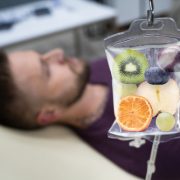How to Detox From Meth
Methamphetamine, commonly known as “ice,” is a potent man-made stimulant that goes by various street names due to its crystalline form. As a highly addictive drug, it can be snorted, smoked, injected, or taken orally. The initial effects include an intense rush of euphoria and heightened energy, impacting neurotransmitters like dopamine and serotonin. This creates a rewarding experience that can set the stage for future ice abuse, with repeated use quickly leading to increased tolerance and higher meth doses.
It isn’t long before an ice addict begins to witness the toll the drug is taking on their mental and physical health, as well as the devastation caused in their life. A destructive cycle of abuse sets in, including meth binges called tweaking. Tweaking refers to the individual not sleeping for days at a time who then develops a sort of temporary psychosis.
Ice addiction is one of the most challenging addictions to overcome, with 92% of those who completed detox relapsing. Anyone who has read or seen the movie version of Beautiful Boy learned about the intense grip the drug had over Nic Sheff, who succumbed to repeated relapses before eventually beating the ice addiction. It is possible to successfully recover from an ice addiction, with the first step being detox and withdrawal. When considering undergoing detox from this drug, some may inquire how to detox from ice at home.
The Benefits of Home Detox For Meth Addiction
When facing down the prospect of getting clean before going through a treatment program there are a couple of detox options available, including the inpatient detox center option and an at-home detox. For many, the idea of staying in a detox facility is not ideal, which brings us to the concept of detoxing from ice at home.
An at-home detox and withdrawal process has several benefits. These include:
- Going through detox at home offers a sense of comfort and familiarity
- An at-home detox ensures privacy and confidentiality
- Being home during detox allows the family to be supportive and present
- An at-home detox offers personalized care and attention
Private home detox nurses are trained in addiction treatment, giving them the expertise to monitor for dangerous withdrawal symptoms and respond promptly. The private nurse works under the supervision of a physician who specializes in addiction treatment.
The Effects of Ice Addiction
Once someone becomes addicted to meth, they lose control over their drug-seeking behaviors and usage. This happens because the brain’s chemical structure changes, leading to a decrease in dopamine production. Without the drug, the individual feels no pleasure. As addiction sets in, the individual’s life will begin to unravel. Legal problems, loss of jobs, financial problems, custody issues, and even homelessness will begin to define their days.
Because meth is so toxic, serious health conditions can develop as a result of addiction. Some of the effects of long-term ice abuse include:
- Serious dental problems
- Skin sores, picking at invisible bugs
- Weight loss
- Droopy skin
- Sleep deprivation
- Angry or violent outbursts
- Cognitive and memory problems
- Aggressive behavior
- Mental confusion
- Mood swings
- Anxiety
- Depression
- Auditory and visual hallucinations
- Delusions
How to Detox From Ice at Home Safely
When wondering how to detox from ice at home, it is imperative to understand that this should never be attempted without medical supervision. Meth detox is often accompanied by emotional and psychological withdrawal symptoms, sometimes leading to self-harm or suicide attempts.
A private medical provider who is trained in detox and addiction treatment can accompany the individual through the detox process at home. This is a valuable option, as remaining home for the duration of the detox period can be far less stressful than a detox facility. Some desire a home detox for privacy concerns, while others want their family members close by. These advantages make an in-home detox a desirable avenue to consider when deciding to confront the meth addiction and begin recovery.
Ice Detox Symptoms
Ice withdrawal symptoms begin within 24 hours of the last dosing and can take an average of two weeks to complete. Symptoms will peak at days 7-10, and then begin to subside in severity. Meth withdrawal symptoms include:
- Extreme fatigue and lethargy
- Excessive sleepiness
- Intense cravings
- Increased appetite
- Dry mouth
- Shaking or jittery
- Depression
- Hopelessness
- Apathy
- Hallucinations
- Paranoia
- Delusions
- Suicidal thoughts
While there are as of yet no specific medications to assist in meth withdrawal, there are various medications that can be provided during detox from ice at home that will help reduce discomfort. Wellbutrin, which is an antidepressant, has been shown to help reduce meth cravings. In addition, the drug, Provigil, is a mild stimulant that can help with sleep disturbances.
Getting Treatment for a Meth Addiction
After the individual has successfully completed the detox process at home, they will need to be admitted to a residential treatment program for a minimum of one month, although longer is preferred. Detox only clears the system of the toxins and chemicals associated with methamphetamine, but the addictive behavior patterns remain. The rehab program will provide a comprehensive treatment plan that helps the former meth addict reshape their maladaptive thoughts and behaviors toward positive ones in recovery.
Treatment for an ice addiction includes:
Individual psychotherapy: During these one-on-one talk therapy sessions, the individual will work with a therapist to examine any possible underlying emotional issues related to the addictive behaviors. Among the evidence-based therapies available, cognitive behavioral therapy (CBT) has been shown to be the most effective for treating ice addiction. CBT helps the individual establish new thought-behavior patterns, which act as a powerful recovery skill to override triggers. CBT can also be effective in treating co-occurring mental health disorders such as anxiety or depression.
Group therapy: In the small group sessions a therapist will guide topics of discussion allowing others to share their own personal challenges or stories, which can foster peer support in recovery. Giving individuals a voice, a platform where they can safely discuss their struggles with ice addiction can be a source of renewed confidence. Group support offers an environment that provides fellowship and mutual social support.
Dual diagnosis treatment: Co-occurring mental health disorders are very common among addicts. When there is a coexisting mental health condition it should be treated at the same time as the addiction for best recovery results. It is essential that the mental health piece be treated in order to increase the potential for a long-term recovery. The individual should seek out a rehab program that specializes in dual diagnosis treatment.
12-step recovery program: Many rehabs incorporate A.A.’s 12-step programming into the treatment program, while others may use a non-12-step approach. Recovery meetings provide a non-judgmental setting where individuals gain inspiration from each other, and can establish new sober friendships. The recovery community is a valuable continuing care component as well.
Addiction counseling: Classes that help recovering addicts understand the neurobiological impact of meth on the brain and the central nervous system can be helpful in deterring relapse. Relapse prevention planning is also included in these sessions. Each participant is tasked with identifying his or her own particular triggers and then creating a strategic plan of action when relapse threatens to undermine recovery.
Life skills counseling: Individuals will learn various recovery skills that will help reinforce their ability to stay on track. These might include coping skills, anger management skills, conflict resolution skills, communication skills, and more. Case management can help coordinate various social services that may be needed in early recovery, such as housing, social services, legal services, or employment services.
Continuing care services: After completion of the rehab program, individuals are encouraged to access aftercare services. These include 12-step meetings, such as N.A., weekly therapy sessions, and sober living housing. Continuing care efforts are crucial for maintaining sobriety, particularly during the early stages of recovery.
Individuals who cannot take an extended leave from work or child-rearing responsibilities may need to access an intensive outpatient program (IOP). The outpatient option is not ideal for someone with an ice addiction, however, it is available for those for whom residential care is not an option. Outpatient programming provides the flexibility that allows the individual to remain employed during treatment, which lasts 3-6 months, and many outpatient programs now offer evening classes. Also, the individual is free to live at home, versus in a rehab facility, which can substantially reduce the costs of treatment.
Can the Brain Recover From Ice Addiction?
Ice addiction may be a very challenging substance use disorder to recover from, but it is definitely possible. But what about the damage done to the brain? Can someone who has abused meth reverse the damage this powerful drug has done to the brain? Meth is one of the most potent and destructive drugs of abuse available. The toxic substances that meth is made of will do significant damage to the body, the mind, and the brain. Meth can destroy brain cells, as well s trigger acute changes in the neurotransmitters, even completely remapping the brain’s reward system. Meth can impact motor skills, speech, cognitive skills, and memory.
In recovery, it is possible for the brain to recover to a significant extent. However, the process of healing and restoring function is one that is long, taking about 1 ½ years of continuous sobriety. However, over a prolonged period of sustained recovery, it is possible that the individual will experience improvements in brain functioning.
7 Ways to Avoid Relapse
One of the most daunting challenges for anyone in recovery, regardless of the substance of abuse, is avoiding a relapse. The risk of relapse is particularly challenging in the first year of recovery when the individual is most vulnerable. Relapse will, however, be a constant threat in recovery, so individuals need to remain vigilant in their efforts to avoid it. Here are some tips that can help a recovering addict avoid a methamphetamine relapse:
- A continuing care plan. Before discharge from rehab, make sure there is a solid continuing care plan in place. Upon discharge, have outpatient therapy sessions already scheduled, locate a recovery community, such as N.A. where social support will be provided, and possibly consider staying in sober living for a while until recovery feels more secure.
- Avoid risk. Identifying relapse risks is an exercise that helps the individual to acknowledge the situations, people, or places that may trigger re-occurrence. Once the individual identifies potential threats to their recovery, they will plan specific actions to take when faced with triggering situations. Sticking to the plan and avoiding known risks to recovery is essential in preventing a relapse.
- Mindfulness. Mindfulness meditation is a highly effective tool for managing distracting thoughts and emotions in early recovery. Practicing mindfulness can reduce feelings of stress, and depression, as well as reduce cravings. This form of meditation helps train the mind to shift from negative or stressful.
- Get regular exercise. One of the most productive ways to avoid relapse is to begin a fitness program alongside the recovery journey. Setting fitness goals helps motivate one toward achieving long-term goals. Physical activity helps produce “feel good” brain chemicals, such as endorphins, dopamine, serotonin, and norepinephrine that boost mood, reduce stress, and improve sleep quality.
- Have a trusted confidante. Have someone you can confide in a sponsor, a trusted friend or family member, or a psychotherapist. This person provides a safe, non-judgmental audience for someone to share, without reserve, any feelings of ambivalence about recovery, possible threats to recovery, or the signs of an impending re-occurrence. As a result, this confidante can usher the person to a meeting, engage in a distracting activity, or stay at his or her side as this threat passes.
- Establish a healthy routine. After treatment, it is very helpful to create a new healthy lifestyle that will help support recovery efforts. This involves sticking to a schedule and revamping the diet by increasing lean proteins, omega-3 fatty oils, nuts and seeds, fresh produce, and low-fat dairy while decreasing processed and sugary foods. It also means keeping good hygiene habits and taking care of one’s appearance.
- Use recovery tools. During treatment, the individual will learn several effective strategies to reinforce recovery and prevent relapse. These recovery tools include such things as relaxation techniques, conflict resolution skills, more effective communication techniques, and emotion regulation techniques. Access these tools regularly until they become new habits, which will significantly reduce the risk of relapse.
Kinkaid Private Care Explains How to Detox From Ice at Home
If you or your loved one needs help with detox from ice at home, please visit our In-Home Detox page. See how we can help. Kinkaid Private Care offers premium in-home services to patients looking for the best and most intensive care on the market. We limit our client intake to ensure we provide personalized, specialized care tailored to each client’s unique needs.
For more information, please visit our homepage and learn about our values and the array of services we provide. These services include home detox across California, in-home nursing care, and coordination of various medical services in the Los Angeles area. We also offer at-home Covid-19 testing.













